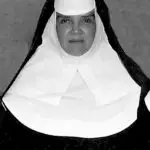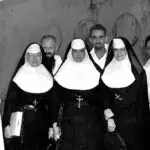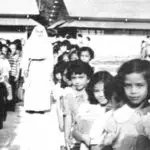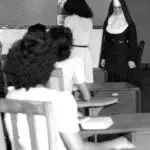Mary Essie Underwood
Catholic school system of Guam founder
Mary Essie Underwood (1906 – 1998), also known as Sister Mary Inez, was one of the first three Sisters of Mercy from North Carolina who came to Guam in 1946 to establish a community of women religious and Catholic schools.
Mary Essie Underwood was born 25 October 1906 in Guam. She was the first of eight children born to James Holland Underwood, a native of Gastonia, North Carolina, and Ana Pangelinan Martinez, a CHamoru/Chamorro. James Underwood was a military officer who came to Guam at the turn of the century.
At a very young age, Mary Underwood’s parents sent her and her sister Eugenia to Sacred Heart Academy in Belmont, North Carolina, a school managed by the Religious Sisters of Mercy, an order of Roman Catholic nuns. She later embraced that order, entering the convent as a novice in 1926, and became Sister Mary Inez.
The decision to send his daughters to Belmont was a very important move by James Underwood. A new relationship between Guam and the Belmont community was established, thus opening the door for other students from Guam to go to Belmont Abbey for high school or college.
In the eulogy at Mary Underwood’s funeral, her niece, Rosemarie Underwood, recalled that fateful move to North Carolina:
There was a certain amount of culture shock for the two (Aunt Mary and Aunt Eugenia) – not only did her grandparents, uncles, aunts and cousins have a different lifestyle, the cuisine was in great contrast to those at home, even their religious beliefs were different. Most of them were Presbyterians, the girls were Roman Catholic. Aunt Mary, though, chose the best. She loved potatoes over rice, southern fried chicken over chicken kelaguen, bread over ‘tityas.’ Mary remained a Catholic no matter how long she was in North Carolina and never forgot to speak Chamorro. And she managed not to pick up the southern drawl that many do when living in the south.
In time, Underwood’s religious community sent her for higher studies, and she received a BA at Mount St. Vincent College, Hudson, New York, and an MA at the Catholic University in Washington, DC. Both institutions granted Underwood scholarships. She returned to Belmont, where she taught and was subsequently appointed administrator of the Academy and Junior College.
Underwood had been away 26 years when in 1946, she responded to her second call – an invitation made by the first American bishop of the Vicariate of Guam – Bishop Appollinaris W. Baumgartner, OFM, Cap., to establish a community of religious sisters on island. Bishop Baumgartner previously had sent requests to several other communities, but none were able to send religious sisters to the island. He finally was able to use the connection between Mary Underwood’s father, James Underwood, and the Sisters of Mercy in Belmont. Mother Maura Buchheit, Superior of the Sisters of Mercy of North Carolina, after much prayerful deliberation with her community sent three of her nuns – Sister Mary Inez (Mary Underwood), Sister Mary Louise and Sister Mary Annette to Guam who arrived on the island in November 1946.
Shortly before World War II, Guam’s predominantly Catholic population was served by American Capuchin priests under the direction of Bishop Miguel Olano, a Spanish Capuchin who followed the centuries old Spanish Catholic traditions of his predecessors in the Marianas. In the rebuilding of the Church after the war, Bishop Baumgartner introduced American Catholic traditions. He was also interested in formalizing religious instruction and Catholic education on the island. Because Guam was still recovering from the ravages of World War II, the challenges of educating the young population was overwhelming. However, armed with much courage, comfort in being a native of Guam and her understanding of the language and culture of the Chamorro people, Underwood took the lead in working with the Bishop and eventually established the first convent of the Sisters of Mercy in Guam. By 1947, the first group of 20 young women were received into the Mercy community.
Then, Underwood, along with Bishop Baumgartner, founded the island’s Catholic School System. In 1949, the Sisters of Mercy opened the doors to Guam’s first Catholic schools. Underwood became the co-founder and first principal of the Academy of Our Lady of Guam – a high school for girls in Hagåtña — and Cathedral Grade School, the present Bishop Baumgartner Memorial School now located in Sinajana. She helped recruit not only students for the new Catholic schools, but also encouraged a number of Chamorro girls to enter into religious life.
Underwood was the first superior, educator and mentor for the young girls hoping to become Sisters of Mercy. In the early years of this newly-found religious community, Underwood was the moving force in the pursuit of higher learning for the nuns, and the inspiration for many young women desiring to dedicate their lives to service for God and for the Church.
Her assignment in Guam having been achieved, Underwood returned to North Carolina in 1953. Underwood’s life then took a different turn. As fellow religious Sister Mary Mark Martinez said, “God had other plans for her. She was destined to return to her secular status as Mary Underwood.”
Underwood lived and worked in California for many years but communicated continually with the Sisters of Mercy and her family in Guam In January 1995, Underwood returned to Guam at the invitation of the Sisters of Mercy, with whom she lived until her death on 9 March 1998 at the age of 91. Prior to her death, Underwood was reunited in 1996 with Sister Mary Annette and Sister Mary Louise, the original group that arrived in 1946, to celebrate the 50th anniversary of the Sisters of Mercy in Guam.
As a Sister of Mercy, Underwood left an indelible imprint on her Church and her religious community, especially in the Guam mission. Her energy and vitality made her a memorable and beloved woman for the people who knew her. Today, the Religious Sisters of Mercy in Guam are a vibrant community that has extended their service and commitment to communities all over Micronesia.
From humble beginnings, the school system Mary Underwood and Bishop Baumgartner founded now include four high schools, seven elementary and middle schools, and three pre-school educational institutions. These schools have graduated thousands of students, many of whom pursued higher education and or have held positions of leadership and service, especially to the Guam community. As a religious sister, she had no children of her own. But as her nephew, University of Guam President and former US Congressional delegate Dr. Robert A. Underwood said of Mary Essie Underwood in his 1998 tribute to her before Congress, “…there are thousands of children and adults in Guam who are inheritors of her educational legacy.”
For further reading
I Manfåyi: Who’s Who in Chamorro History. Vol. 1. The Hale’-ta Series. Hagåtña: Political Status Education and Coordinating Commission, 1995.
Tribute to Mary Essie Underwood, Before the 105th Congress, 2nd Session, E377 (1998) (Extension of Remarks of Robert A. Underwood, Congressmen of Guam).




